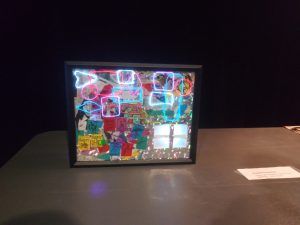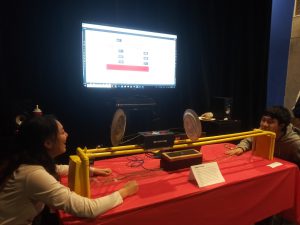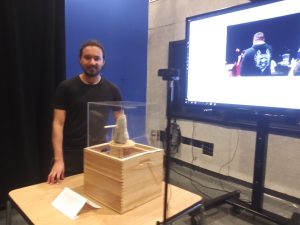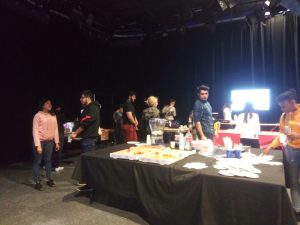 The Hunter North TV studio was the scene for an interactive art show by the students in Emerging Media courses: Interactive Installation, Physical Computing, Creative Code and Animation. The dimly lit room at the end of the hall on the fourth floor of Hunter North displayed projects that the students had worked on all semester.
The Hunter North TV studio was the scene for an interactive art show by the students in Emerging Media courses: Interactive Installation, Physical Computing, Creative Code and Animation. The dimly lit room at the end of the hall on the fourth floor of Hunter North displayed projects that the students had worked on all semester.
Several tables were set up around the room. On one, a box with printed images glued onto it and lit from above tried to capture the chaotic city streets at night.
“I created this to symbolize city lights,” said Jessica Garcia, the media student who created it. She explained that the lights can be programmed to flash at different times depending on how an artist wants to approach the project. All these techniques are taught in the department’s Physical Computing class.

Another table had an interactive installation where student Belinda Liang was presenting her project RELAX! – she based the game off the board game Pie Face. The only difference is Liang programmed the machine to move the plate of whipped cream towards the opponent based on heart rate. The higher the heart rate, the higher the chance of getting hit in the face with the plate that had whipped cream on it. The table was surrounded by students who were willing to give the game a try. One student even took the whipped cream can and put some on his pizza once he lost.
Grad student Fabio Silva displayed his iMine project, created in Interactive Installation, which focused on bringing to light how machines take all kinds of information from the public and store it somewhere in cyberspace. His art piece  showed how data is stored. In a glass case sat a stone that was being marked up by a pencil. The stone would get a mark every time someone made a movement in front of the camera he had connected to it.
showed how data is stored. In a glass case sat a stone that was being marked up by a pencil. The stone would get a mark every time someone made a movement in front of the camera he had connected to it.
“The way our computers work is, the sensors are digitizing our bodies,” said Silva. “Our face, bodies and how we walk is all stored in through numbers.”
He added that this is a privacy concern that he feels should be addressed. “This data can then be accessed by companies and they can sell the information if they choose to,” said Silva.
 The event was very casual and allowed visitors to socialize with the students while they talk about their projects.
The event was very casual and allowed visitors to socialize with the students while they talk about their projects.

